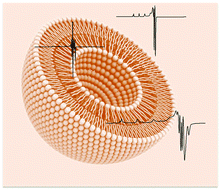Distinctive EPR signals provide an understanding of the affinity of bis-(3-hydroxy-4-pyridinonato) copper(ii) complexes for hydrophobic environments†
Abstract
In this work we report the synthesis and characterization of a set of 3-hydroxy-4-pyridinone copper(II) complexes with variable lipophilicity. EPR spectroscopy was used to characterize the structure of copper(II) complexes in solution, and as a tool to gain insight into solvent interactions. EPR spectra of solutions of the [CuL2] complexes recorded in different solvents reveal the presence of two copper species whose ratio depends on the nature of the solvent. Investigation of EPR spectra in the pure solvents methanol, dimethylsulfoxide, dichloromethane and their 50% (v/v) mixtures with toluene allowed the characterization of two types of copper signals (gzz = 2.30 and gzz = 2.26) whose spin-Hamiltonian parameters are consistent with solvated and non-solvated square-planar copper(II) complexes. Regarding the potential biological application of ligands and complexes and to get insight into the partition properties in water–membrane interfaces, EPR spectra were also obtained in water-saturated octanol, an aqueous solution buffered at pH = 7.4 and liposome suspensions, for three compounds representative of different hydro-lipophilic balances. Analysis of the EPR spectra obtained in liposomes allowed establishment of the location of the complexes in the water and lipid phases. In view of the results of this work we put forward the use of EPR spectroscopy to assess the affinity of copper(II) complexes for a hydrophobic environment and also to obtain indirect information about the lipophilicity of the ligands and similar EPR silent complexes.


 Please wait while we load your content...
Please wait while we load your content...